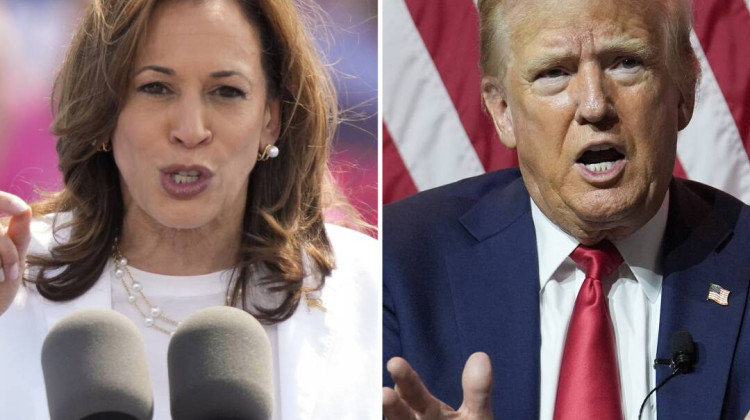
Shane Hatchett, Indiana Department of Health chief of staff, gives a presentation at the Governor’s Public Health Commission’s November meeting focused on funding.
(Farah Yousry/WFYI)Indiana’s public health commission is considering ways to overhaul the state’s funding model, which is riddled with problems and leaves many Hoosiers without crucial preventive interventions. The 15 members of the Governor’s Public Health Commission met Nov.18 and agreed there needs to be a cultural shift to improve Indiana’s public health status.
“We haven't looked at this issue since maybe about 1992,” said Dr. Virginia Caine, director of the Marion County Health Department. "We are trying to look at what's on our books in terms of regulations, policies that we have.”
Hoosiers have some of the highest rates of chronic but preventable conditions like obesity and diabetes. Health experts say that’s largely because Indiana spends less money on public health per person than nearly all other states. Caine said there needs to be a change in the state’s funding model.
Indiana’s public health budget relies heavily on federal grants. But these grants are often prescriptive and not sensitive to local communities’ specific needs.
“A lot of times when we get funding or resources, it's restricted so I don't have discretionary dollars to really tackle the problem that I have in my county,” Caine said. “So I may have funding for the whole state to address this issue, but maybe I'm good on those resources. So you're not really helping me out. So how can we get discretionary dollars?”
Many local health departments rely on local property tax for additional funding. But this puts counties with lower home values at a disadvantage, which increases health disparities.
Shane Hatchett, the chief of staff of the Indiana Department of Health, presented data that showed how county health funds based on property tax distribution varies widely –– with some counties like Marion and Brown receiving double digit funds per capita and others receiving less than $3 per capita.
“As we've said all along, your public health should not depend on the zip code that you live in,” said Dr. Kristina Box, the state health commissioner and secretary of the commision. “And our public health workers have been working so incredibly hard these past two years to meet all of these needs.”
Box said some local health departments have as few as three full-time employees while others have more than 100 full-time employees.
“And they're still asked to do the same amount of services,” she said.
Local health departments are among the first line of defense in a community. These offices work with health and community partners to monitor and prevent disease outbreaks and promote healthy lifestyles.
Cara Veale, chief executive officer at Indiana Rural Health Association, said it’s hard for local health departments in rural areas to focus on preventive medicine when they do not have the workforce to support clinical and non-clinical interventions.
“When it comes to financial resources in our rural communities, we struggled greatly. A lot of our rural communities have aging infrastructure and are limited in human resources,” Veale said. “A lot of our health departments don't have a full-time person. That can translate into a lot of errors [or] missed responsibilities.”
The system in Indiana often pushes many local health departments to leave much-needed money on the table. Indiana Department of Health surveys from 2020 show that many local health departments are unable to bill Medicaid and most are unable to bill Medicare due to issues like lack of training on software, billing assistance and dedicated staff to stay up-to-date on changes in Medicaid policies. The result: less than half of the state’s local health departments billed the federal government for services they provided.
“Only 46 local health departments actually submitted a claim within this one-year period, for a total of $1.24 million being paid out during that time,” Hatchett said.
He added that many local health departments report that when their employees do build up expertise in billing Medicare and Medicaid, they get poached by hospital systems in the area.
Local health departments in most other states also rely on a combination of state and federal funds, but the system is working better in some places. The commission is looking at three states where officials say the public health funding model is working a lot better than in Indiana: Washington, Ohio and Kentucky.
The earliest changes in public health funding will be considered in 2023, when lawmakers draft the next state budget. Until then, the commission plans to convene monthly and speak with local health experts, economists and lawmakers to come up with proposals.
Former Republican state Sen. Luke Kenley, co-chair of the commission, said their efforts rely on one thing.
“In the end, if we can’t sell the legislature, the work is in vain,” he said. “I hate to be that blunt but that’s just the way it is.”
Gov. Eric Holcomb established the Governor’s Public Health Commission in August.
Contact reporter Farah Yousry at fyousry@wfyi.org. Follow on Twitter: @Farah_Yousrym.
 DONATE
DONATE





 View More Articles
View More Articles



 Support WFYI. We can't do it without you.
Support WFYI. We can't do it without you.